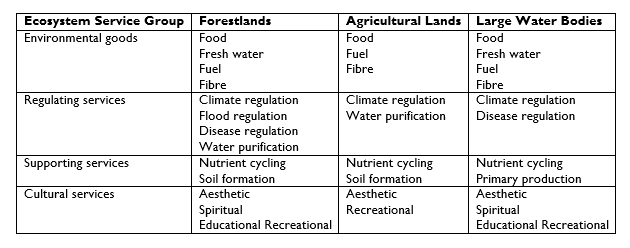¶ Payments for Environmental/ Ecosystem Services
Payment for Environmental Services (PES)[1] has recently received a great deal of attention as a new, innovative and promising approach to mobilising resources for implementation of forestry programs, projects and activities. In this Handbook, PES is defined as a contractual agreement between an environmental service beneficiary and an environmental service producer (or an intermediary acting as one of them), by which the former transfers resources to the latter, provided the environmental service producer adopts specific practices on the land or resource he controls or possesses, to enhance the production of a specific environmental service.
According to Forest Trends[2], ecosystems provide society with a wide range of services — from reliable flows of clean water to productive soil and carbon sequestration. People, companies, and societies rely on these services for raw material inputs, production processes, and climate stability. See Table 15 for a breakdown of ecosystem service types
Table 15: Types of Ecosystem Services

Adapted from: Millennium Ecosystem Assessment, 2005. https://www.millenniumassessment.org/
Instruction 365: If the FMI is planning to package and market Environmental/ Ecosystem Services, the standard practices and steps to follow are outlined below (Forest Trends 2008)[3]
(i) Identify ecosystem service prospects and potential buyers (defining, measuring, and assessing the environmental service in a particular area; determining marketable value; identifying prospective buyers; considering whether to sell as individuals or as a group)
(ii) Assess institutional and technical capacity (assessing legal, policy, and land ownership context; examining existing rules for PES markets and deals; surveying available PES-support services and organizations)
(iii) Structure agreements (designing management and business plans; reducing transaction costs; reviewing options for payment types; establishing the equity and fairness criteria for evaluating payment options; selecting a contract type)
(iv) Implementing PES Agreements (finalizing the PES management plan; verifying PES service delivery and benefits; monitoring and evaluating the deal)
Instruction 366: FSC has issued a detailed Ecosystem Services Procedure for use by applicants for, or holders of, a valid FSC forest management certificate who wish to make an ecosystems services claim (FSC 2018)[4]. If the FMI wishes to claim payments for PES, the FMI shall apply to an accredited Certification Body to be certified first.
The phrases “environmental services”, “ecosystem services” and “ecological services” are often used interchangeably as there is currently no clear consensus on their exact definitions and differences. In general, ecosystem services refer to the benefits derived by human beings from the ecosystems (Millennium Ecosystem Assessment, 2005) while environmental services are services rendered by people to other people for the maintenance or the improvement of a given ecosystem service (Karsenty, 2013). The environmental services notion is generally used in the framework of payment mechanisms (Antona and Bonnin, 2010) and is what is used in this Handbook with respect to Payments for Environmental Services. ↩︎
Forest Trends, The Katoomba Group, and UNEP. 2008. Payments for Ecosystem Services Getting Started: A Primer ↩︎
ibid ↩︎
Forest Stewardship Council. 2018. Ecosystem Services Procedure: Impact Demonstration and Market Tools ↩︎